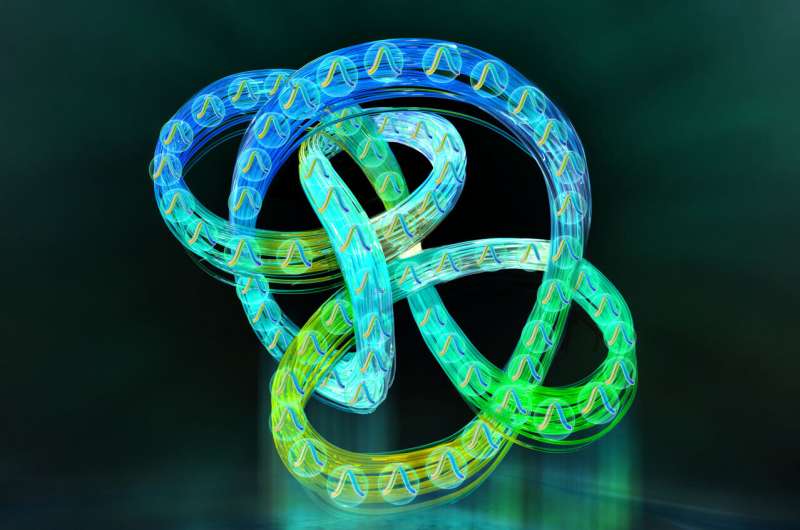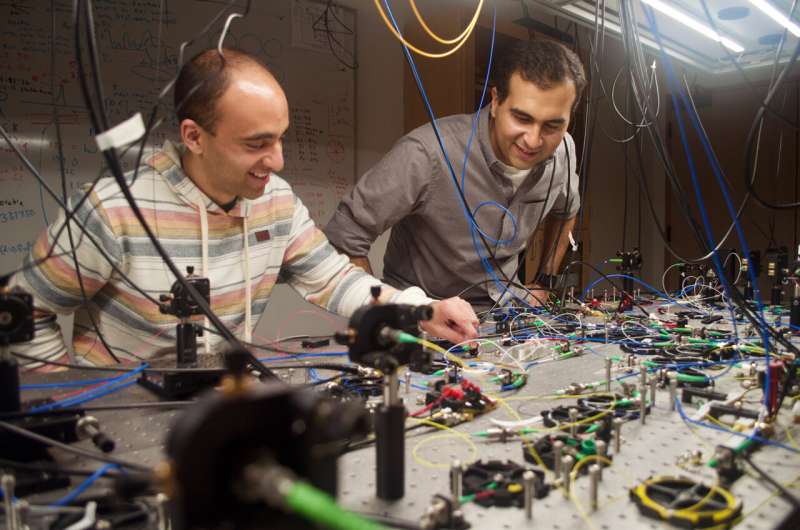An artistic illustration of the concept of topological dissipation in a time-multiplexed photonic resonator network. Credit: Nicolle R. Fuller, Savo Studio
So far, physicists have primarily studied topological phases in conservatively coupled systems. These are systems with dynamics that do not dissipate and a phase space that does not shrink over time. They are in stark contrast with dissipative systems, which are thermodynamically open systems (i.e., operating out of thermodynamic equilibrium) marked by dynamics that can dissipate over time.
Researchers at California Institute of Technology, Stanford University, and other institutes worldwide have recently introduced and experimentally demonstrated topological phases in a dissipatively coupled system. Their paper, published in Nature Physics, could ultimately inform the development of new technologies that are less susceptible to manufacturing defects.
"Our dissipatively coupled topological phases manifest nontrivial topology in the dissipation properties of a system: a fundamentally new concept that we term topological dissipation," Alireza Marandi, one of the researchers who carried out the study, told Phys.org. "Topological dissipation presents a new direction of study for topological physics and has the potential to inspire novel devices for solid-state electronics, phononics, and photonics that are immune to environmental noise and resilient to fabrication imperfections."
In addition to demonstrating topological phases in a dissipative system, Marandi and his colleagues realized an experimental platform that could improve the study of topological physics. More specifically, they used time-multiplexed resonator networks to create a large-scale, flexible platform to study topological photonics.
"In our paper, we showcase some of the platform's capabilities, for instance in the same setup without any hardware modifications, we can change the boundary conditions, and switch from a topological lattice to a trivial lattice in the middle of the experiment and study exotic dynamics," Marandi explained. "Our platform is readily scalable to even more synthetic dimensions and can implement complex long-range couplings, providing a straightforward template to study physics in densely connected lattices and in four or more dimensions."
The platform designed by Marandi and his colleagues consists of a network of photonic resonators, linked by "dissipative" connections. This essentially means that each of the paths connecting the resonators can leak some photons and cause them to leave the network, depending on how the light in the connection interferes with the light in the resonators (e.g., constructively or destructively). In more technical terms, the dissipation of the network created by the researchers depends on its supermode and on how this supermode is excited.
Christian Leefmans (left) and Alireza Marandi (right), standing next to the experimental setup. Credit: A. Marandi.
"We have analytically shown that in a purely dissipatively coupled network, when the network represents a lattice, a topological lattice in our case, the dissipation rates of the modes would be equivalent to the energy bands of the lattice and we could observe topological behaviors in those dissipation rates," Marandi said. "For instance, in a specific case, we could observe that the quality factor of the supermode of the network would be topologically protected against disorders on the network."
The platform created by Marandi and his colleagues was fabricated using off-the-shelf fiber optics–based components and was driven using a short-pulse laser. To program the optical machine and adapt it to a specific lattice, the researchers used an FPGA system, a hardware circuit used to carry out logical operations.
The results achieved by this team of researchers could lay the groundwork for further theoretical studies and experiments focusing on topological phases in dissipative systems. In addition, the dissipatively coupled topological phase demonstrated by the researchers could also be relevant to other areas of physics, including condensed matter physics, photonics, and the study of ultracold atoms.
"Dissipatively coupled topological phases feature robust topological states with isolated dissipation rates," Marandi said. "This property also provides a new way to engineer the dissipation of a system and could be useful for designing devices such as quantum memories, photonic sensors, and topological amplifiers."
In the future, the recent work by Marandi and his colleagues could also be of interest for teams focusing on a relatively new area of research, namely non-Hermitian topological physics. In fact, the dissipative properties of the topological phases they unveiled could be combined with the gain and loss observed in non-Hermitian systems to realize new topological effects. These effects could in turn enable the development of new, robust, and very powerful lasers.
"We now plan to study fundamental physics that are enabled by the flexibility and scalability of our machine," Marandi said. "In that direction, we are studying some exotic topological and non-Hermitian dynamics that have been beyond the reach of previous experimental platforms. The other research direction that we pursue is related to applications, as we believe that the notion of topological dissipation can be an additional resource for photonic systems. Specifically, we are currently leveraging such topological phases to create mode-locked lasers and photonic sensors."
More information: Christian Leefmans et al, Topological dissipation in a time-multiplexed photonic resonator network, Nature Physics (2022). DOI: 10.1038/s41567-021-01492-w
Journal information: Nature Physics
© 2022 Science X Network

























